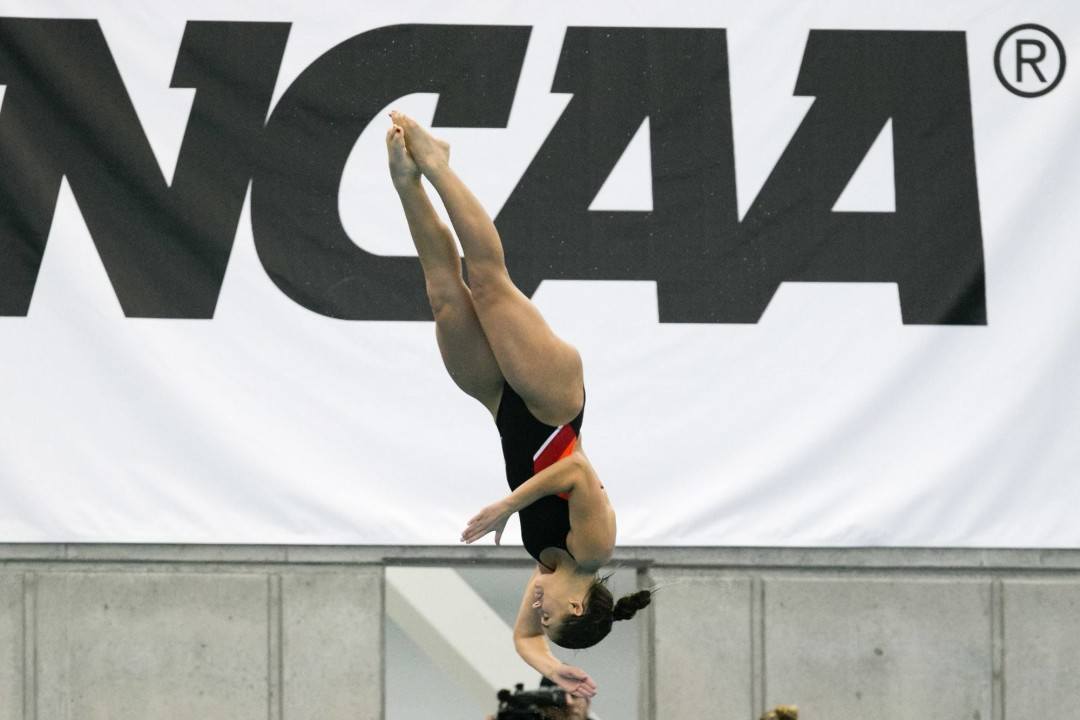As NCAA Zone Diving events begin this week across the country, we’ll be following each meet and its NCAA qualifiers. But before the action starts, here’s a quick refresher on how the NCAA selects the divers to compete at the national championships.
NCAA Zone Qualifying Procedures
Divers qualify for the NCAA Championships through Zone Meets spread across the country. Each zone earns a set number of NCAA qualifying spots based on the performances of that Zone at NCAAs in the past.
Here are the qualifying spots for each event in each zone:
Women
| 1m | 3m | Platform | |
| Zone A | 5 | 6 | 6 |
| Zone B | 9 | 8 | 7 |
| Zone C | 12 | 7 | 10 |
| Zone D | 6 | 9 | 9 |
| Zone E | 9 | 11 | 9 |
Men
| 1m | 3m | Platform | |
| Zone A | 4 | 5 | 4 |
| Zone B | 10 | 10 | 8 |
| Zone C | 7 | 9 | 8 |
| Zone D | 7 | 7 | 8 |
| Zone E | 8 | 5 | 8 |
Any diver who finishes within the qualifying spots for their zone earns eligibility for the NCAA Championships. Any diver who earns eligibility in one event can compete in any of the other two events at NCAAs, provided they finished inside the top 12 in their zone in that event.
The final wrinkle is a new rule from last season that makes a distinction between “eligible” athletes and “reimbursed” athletes. The NCAA loosened its rules last season to allow more divers into the meet, but divers qualifying under the new rules do not recieve reimbursement from the NCAA for their travel, lodging and meet expenses – that means it’s up to the individual school to decide if they will foot the bill themselves to allow the diver to compete at NCAAs.
Each zone has a set number of reimbursement spots between the three events combined:
| Women | Men | |
| Zone A | 5 | 4 |
| Zone B | 8 | 9 |
| Zone C | 11 | 8 |
| Zone D | 7 | 8 |
| Zone E | 10 | 6 |
The spots are determined by a priority chart. The winners of each event have first priority, starting with the 3-meter champ, then the 1-meter champ, then the platform champ. After that, the runners-up are added in the same order. If an athlete wins both 1-meter and 3-meter, they still only take one reimbursement slot, meaning the NCAA will keep adding rows of this chart until the reimbursement quota for that zone is met:
| Priority | Finisher |
| 1 | 3-meter Champ |
| 2 | 1-meter Champ |
| 3 | Platform Champ |
| 4 | 3-meter 2nd |
| 5 | 1-meter 2nd |
| 6 | Platform 2nd |
| 7 | 3-meter 3rd |
| 8 | 1-meter 3rd |
| 9 | Platform 3rd |
| 10 | 3-meter 4th |
| 11 | 1-meter 4th |
| 12 | Platform 4th |
| 13 | 3-meter 5th |
| 14 | 1-meter 5th |
| 15 | Platform 5th |
| 16 | 3-meter 6th |
| 17 | 1-meter 6th |
| 18 | Platform 6th |
| 19 | 3-meter 7th |
| 20 | 1-meter 7th |
| 21 | Platform 7th |
| … | …and so on |
You can find the full NCAA qualifying procedures in the Pre-Championships Manual here.
Zone Championship Meets
- Zone A – March 7-9, US Naval Academy (results)
- Zone B – March 7-9, Georgia Tech (results)
- Zone C – March 10-12, Purdue (results)
- Zone D – March 7-9, Texas A&M (results)
- Zone E – March 7-9, Northern Arizona (results)
Though we are SwimSwam and not DiveDove, we will be following all five zone meets, with a special eye on how diving qualifiers will affect the team races at the NCAA Championships later this month. If the above explanation sounds like a foreign language to you, fear not: we’ll be giving you a simplified rundown each day of the locked-in and likely NCAA qualifiers from each zone.

Do you know of any diver that qualified but wasn’t reimbursed whose school didn’t pay for he or she to go to the meet?